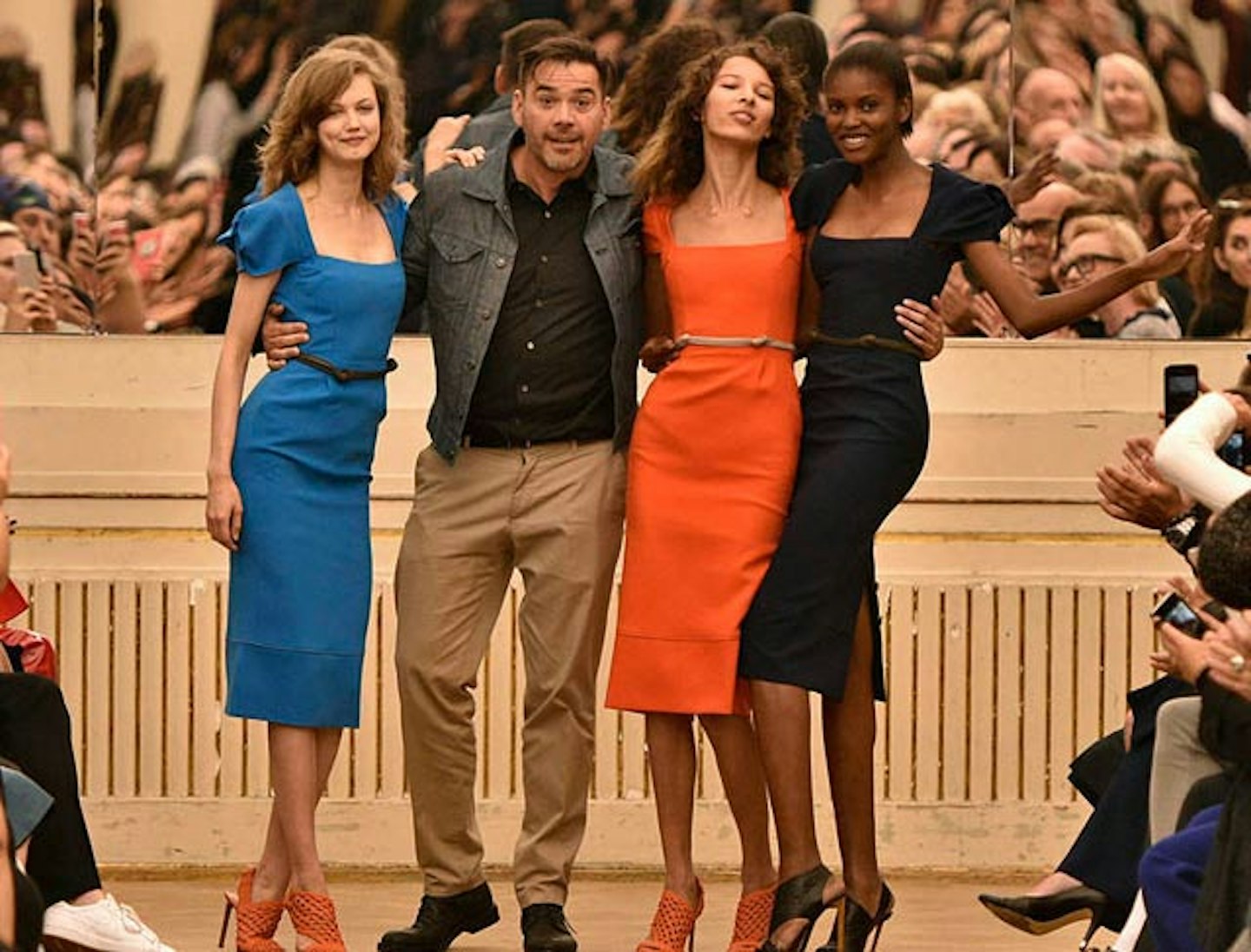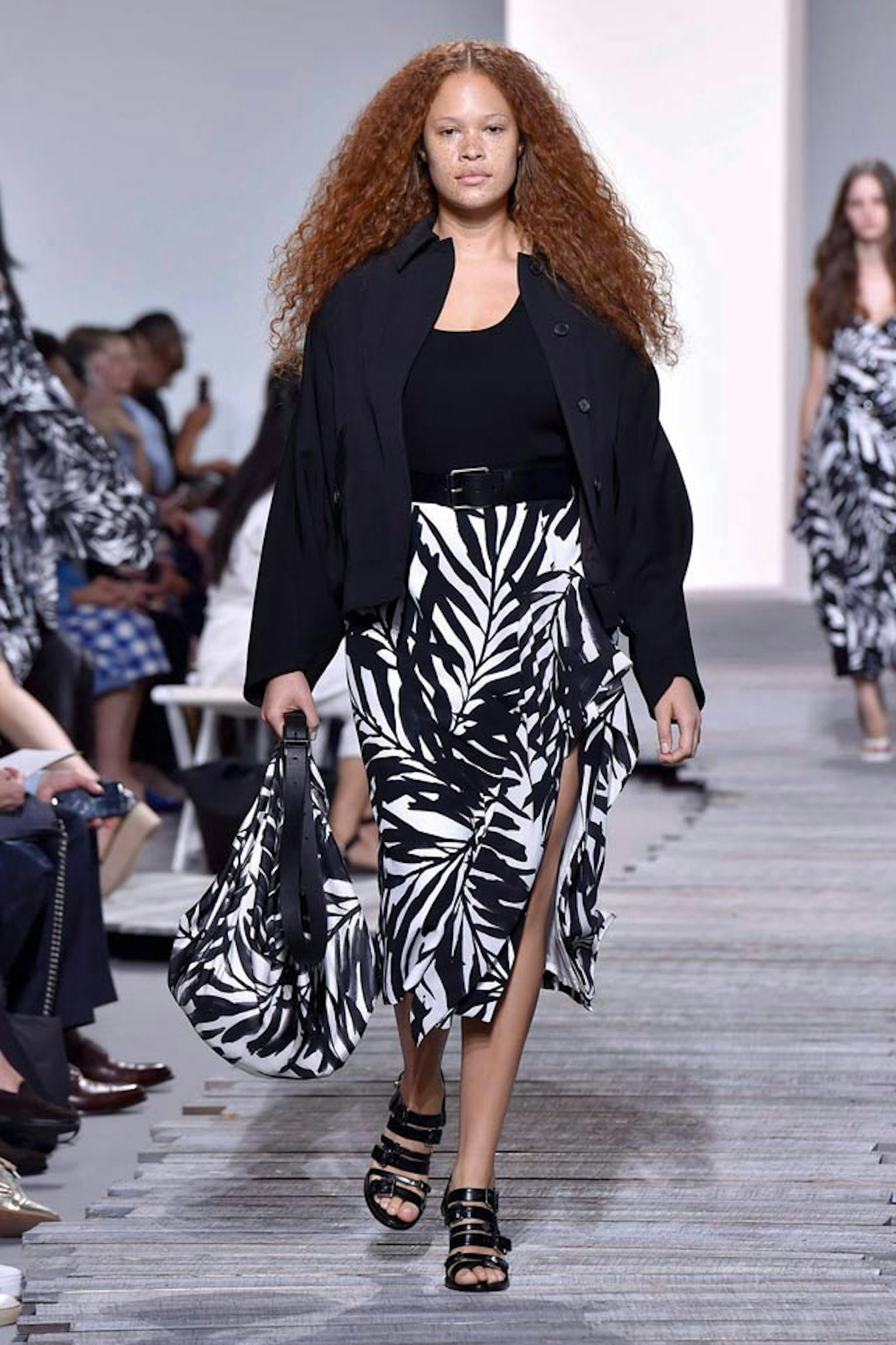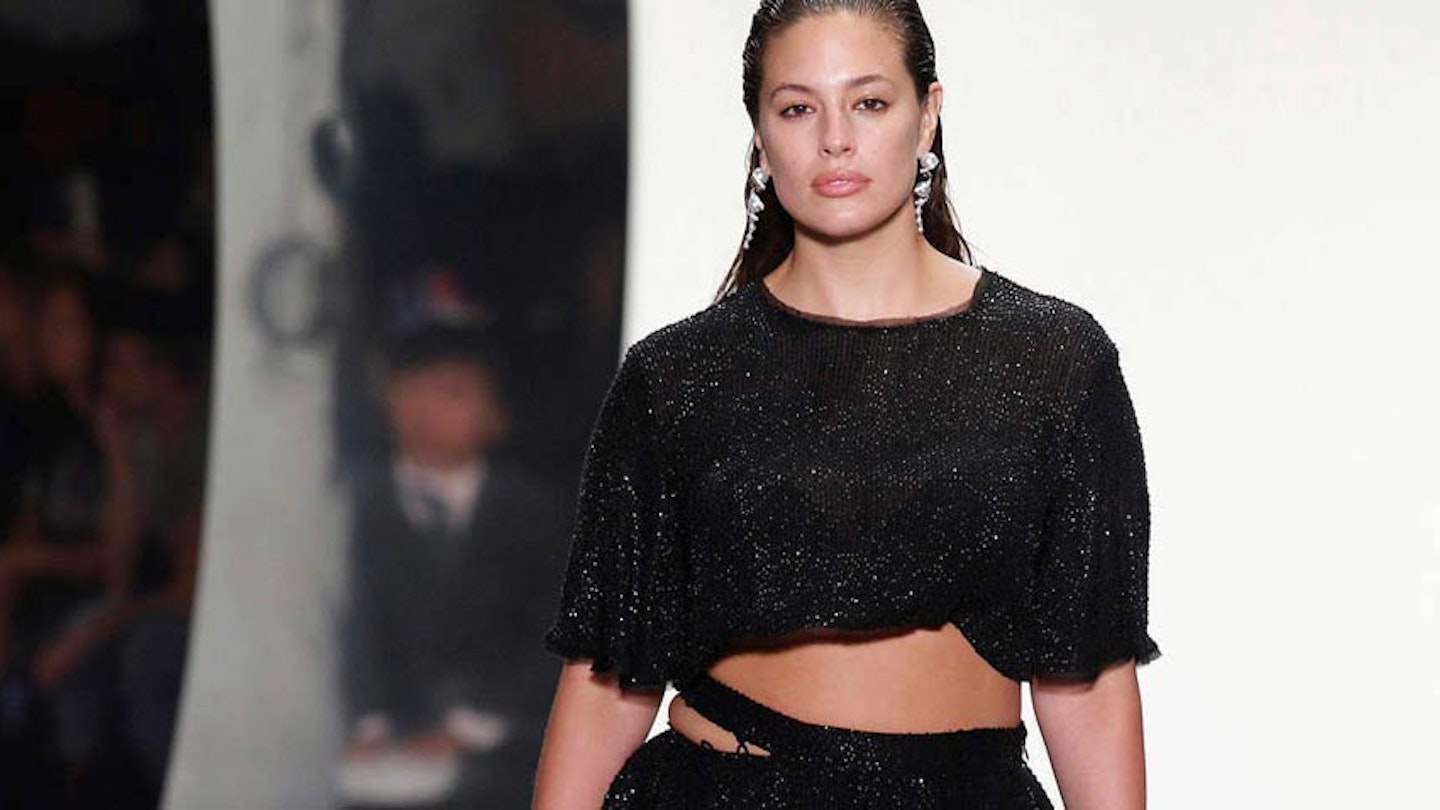A confession: if I had one wish, I would probably use it not to be richer or smarter, but thinner. Much thinner. I am ashamed to admit it, of course, but the pursuit of skinniness has occupied a disproportionate amount of real estate in my mind for the past 20 years. During those two decades I have almost always been on a diet. When not on a diet, I am planning one or commiserating falling off one (masochism doesn’t equate to success).
In fact, most women I know – smart, switched-on, engaged and aware – live with the complicit understanding that skinny is superior. I’ve lived with that white noise since I bought a fashion magazine for the first time aged 12.
The thin factor resonates throughout society, from music videos to adverts, dolls to reality TV, but nowhere is that klaxon sounded louder than in fashion. All models generally conform to one generic standard of beauty: probably young and white, definitely tall and thin.
I’m a size 10 when I’m off carbs and closer to a 14 in January. I am always 5ft 2in in bare feet with a shockingly unfashionable bra size. I am smaller than the average UK size but fat by fashion standards. The average British woman – size 16, 5ft 3in with 36DD boobs – remains woefully under-represented.
The reason why fashion has to be singled out is, ironically, for many of the reasons I fell in love with it: the fantasy, the artistry, the beauty. The problem is that the artistry is so inextricable from the one body type consistently shown. We’re being sold a lie: even the models don’t look like that without professional hair and make-up, expert lighting and airbrushing. We shouldn’t mistake the subtleties of beauty for a BMI.
Now the industry – which has played dumb for so long – is starting to admit that, yes, maybe this is an issue. Recently, luxury conglomerates LVMH and Kering unveiled a joint charter, banning models under French size 32 (UK 6) from walking in their shows. Like most high-profile brands, both have got into hot water with size issues before. And we hold our hands up too: Grazia has been complicit in perpetuating the thin ideal. When we highlighted this very issue in a piece about plus size earlier this year, we were inundated with letters from readers holding a mirror up to our own hypocrisy. (Extract: ‘Is it any wonder that designing for a broad spectrum of sizes is not taught when magazines such as Grazia persist in only featuring models who are a size 8 at best?’) You said it, we’re listening. That’s why this, our flagship fashion issue, includes two shoots with plus-sample-size models: Body Rocking and Wardrobe Workshop. I wish my 12-year-old self could see this. In fact, I hope most women I know now will see this.
**WATCH: Most expensive dresses in history **
Let’s be clear: this isn’t about curves = good, thin = bad. It isn’t about size zero shaming or fat fetishising. Rather, it’s recognising that there are a million shades of grey in-between fat and thin, that skinny isn’t the only definition of beauty and sample size isn’t an attainable goal for all. Surely, we don’t want the next generation to believe that self-worth is determined by a thigh gap? As Sophie Walker, leader of the Women’s Equality Party, which spearheads a #NoSizeFitsAll campaign, tells me, ‘It’s time to dispel once and for all the disturbing insistence on excessively thin models. Fashion and beauty should come in all shapes and sizes.’
To address the problem, you have to understand it – and, frankly, we even struggle to de ne it. We cringe at the term ‘plus size’, but the language around it is clunky (some prefer the term ‘curve’ as it refers to body type rather than size) and the de nition hazy. Some plus- collections start at a size 12, others an 18. For the sake of argument, in this piece we’ll take plus size as meaning 16+.
Tomes could be written on why we’re confronted with such a monotone definition of beauty, but let’s start with one word: samples. The one-off pieces made by designers for fittings, catwalk shows and for magazines to shoot (prior to the item going into mass production in the range of sizes you’ll see in shops). Samples typically come in a size 6-8; naturally, for a model to fit them she too must be a 6-8. This means that even if magazines want to use bigger models, their hands are tied (for the Body Rocking shoot, our fashion editor had to borrow shop stock). ‘I’ve had stylists say to me, “I’d love to use this girl but she isn’t a sample size.” That’s the root of the problem,’ says model agent Anna Shillinglaw, founder of MiLK Model Management, which represents ‘curve’ models and aims to challenge the standardised definition of beauty.
In turn, designers argue they make clothes that size because A) that’s what magazines want; B) it’s costly to make more than one set of samples or set up a production run for more size options; and C) it’s trickier to make bigger pieces as sizing up often requires a redesign. ‘Achieving the perfect fit requires more technical knowledge in grading, ensuring shape and style details are not lost or compromised as the garments get bigger,’ concedes Ralph Tucker, product director at Simply Be, the curve specialist that sells clothes in sizes 12 to 32.

Designer Roland Mouret, whose bombshell hourglass dresses run from a size 6 to 20, thinks you just have to be willing to accommodate different body types. ‘It’s just you being professional enough to understand that the body changes. Someone might be a bigger size but at-chested and someone else might be really small but with big breasts,’ he says. Mouret credits meeting his actual customers with giving him a better understanding of how women want and need to dress. ‘The day I understood the difference between a woman and a model – that a woman wears a bra in the day and the model doesn’t because she’s 16 and we only employ her for a few minutes on the catwalk – made a big difference.’
The sad truth, however, is that many designers don’t want to listen. What other explanation can there be for knowingly ignoring a market that’s there for the taking? The size 16+ womenswear market is worth £2.9bn and the size 20+ market alone worth £335m in the UK.
Huge swathes of the industry remain defiantly snobby about dressing everywoman. ‘The fashion world is quite “fattist”,’ says Mouret, saying, somewhere along the line, the ‘dream of fashion’ has got confused with the pursuit of weight loss. We experienced it in creating this issue – some brands flatly refused to
be included in a plus-size feature.
Prabal Gurung, the Nepalese-American designer who’s dressed everyone from Olivia Palermo to Michelle Obama, experienced this snobbery first-hand this year when he joined forces with US plus-size retailer Lane Bryant. The collaboration gave Gurung the chance, ‘to speak to this woman, to tell her, “I see you and I want to dress you”, yet it was met with sniggering. People were surprised by the stand we took by partnering with Lane Bryant. But that’s the reason I did this collaboration – to create a dialogue about the need for inclusion, and to change people’s minds,’ he says.
Perhaps, slowly, people’s minds are changing. Gurung’s collaboration is certainly indicative of a shift in attitude towards plus size among the highest echelons of fashion. ‘The truth is, we’ve long been dressing women of all ages, sizes and shapes, and we’re happy to have the runway reflect that,’ says Michael Kors on his decision to give plus-size super Ashley Graham her high-fashion catwalk debut last season. Plus-sized models also walked for Christiano Siriano, Tome and Gurung. Elsewhere, Dolce & Gabbana and Vivienne Westwood tapped up Alessandra Garcia Lorido and Emma Breschi for their A/W ’17 campaigns (though it’s worth noting there’s a slight fall overall in the number of plus-size campaign castings this season).

It’s fortifying to see cool, emerging designers embracing size diversity too. Take Marques’Almeida, they of frayed denim fame, who street-cast their last show partly in reaction to being, as designer Marta Marques puts it, ‘tired of the standardised image of what a model should look like. Needs to have this height, these measurements, this type of face – it makes no sense!’ She has a point: the reason we love fashion is its endless evolution and the power to surprise – how can our definition of beauty be so one-note and, well, boring?
Retailers are also catching on. Founded by Patrick Herning and Kathryn Retzer, 11 Honoré, an e-commerce site offering high-end styles from the likes of Gurung, Kors and Marchesa in up to a US size 20 (UK 24), launched earlier this year. ‘We want to disrupt the way fashion approaches this underserved woman and provide her with the most diverse and stylish options out there,’ says CEO Herning. ‘Our consumer is excited to finally have access to fashion straight from the runways,’ adds creative director Retzer.
11 Honoré busts the myth that plus-size customers don’t enjoy or want to spend on fashion – they’ve just been locked out of the conversation for too long. When plus-size bloggers Nicolette Mason and Gabi Gregg (combined social media following: 700k) launched their own curve label, Premme, this summer, the response was so overwhelming the website crashed. ‘I think too many brands and designers have made their decisions around plus sizes based on their assumptions or their personal prejudices around plus-size bodies, rather than actually listening to the customer base,’ says Mason, who adds that Premme eschews ‘the antiquated (and boring) “rules” around dressing for our body types’ with its crop tops, cut-outs, bold stripes and a generally unapologetic vibe.
Rules are being ripped up on the high street, too. For too long the plus-size customer has been treated differently. ‘The biggest misconception with the plus-size industry is that it’s a totally different market to the rest of fashion,’ says Tucker. Vanessa Spence, womenswear design director of ASOS, says that ASOS Curve – which offers sizes 18 to 30 – now takes 75% more sales than it did in 2014. She puts that success down to the fact that ‘we approach design in the same way for Curve customers as we would any other, but we’re aware of the variety of body shapes. We want to ensure that [she] is given the same offer as anyone else.’
This sounds uplifting, but the sad reality is that many plus-size collections are still lacking. The models on our Body Rocking shoot told me that a lot of what is available in plus size is either too old for them (the words ‘matronly’, ‘mature’ and ‘grannyish’ pop up a lot) or garishly, obviously sexy. The yawning gap seems to be for effortless, modern pieces. As 20-year-old model Lucy Knell puts it, ‘I want to be able to dress cool, not just sexy.’ Fit is a challenge too – boobs prove particularly hard to accommodate and our fashion editor found good tailoring options were few and far between. Verdict? Signs of progress, could do better.
For real, fundamental change to happen we have to nurture the positive seeds being sewn. To do a token fashion shoot is no use to anyone: we don’t need to see curves treated like gimmicks. At Grazia, that means making a commitment to use non-sample-sized models regularly and include clothes that are available in larger sizes in our shopping pages.
And, of course, it shouldn’t be forgotten that we can all be the agents of change. We can refuse to agonise about our own weight in front of our daughters. We can stop talking endlessly about diets with our friends. We can look in the mirror and thank our bodies rather than perpetuate a monologue of self-disgust. We can wear what the fuck we want. We can practise quiet self-acceptance. We can recognise that we’re all different. And we can own the knowledge that, when it comes to beauty, there is no ‘one size fits all’ definition.
The Big Fashion Issue is on sale now.
READ MORE: The Scientific Reason Why You Should Follow Plus Size Models On Instagram
